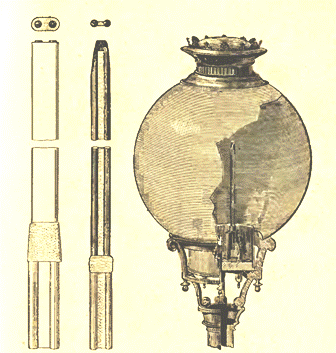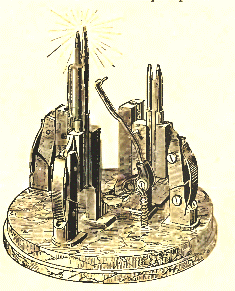Inventions of Pavel Nikolaevich Yablochkov
 The figure shows the "candle Yablochkov", as well as an electric flashlight, as it was first carried out by Yablochkov. When working with alternating current, both coal are burned at the same speed, the insulating mass between them evaporates and, thus, the constant distance between the ends of the coals and the constant length of the electric arc remain, regardless of the oscillations of the arc supply voltage.
The figure shows the "candle Yablochkov", as well as an electric flashlight, as it was first carried out by Yablochkov. When working with alternating current, both coal are burned at the same speed, the insulating mass between them evaporates and, thus, the constant distance between the ends of the coals and the constant length of the electric arc remain, regardless of the oscillations of the arc supply voltage.
In Fig. 1 and 2 shows the proposed device proposed by Yablochkov to house four candles in the lamp, which are ignited one after the other with the help of a switch as each of them burns. The result of Yablochkov's experiments was not only the development of a candle. He found that the resistance of many refractory bodies to electric current, such as: kaolin, magnesia, etc., decreases with heating, contrary to the widely held opinion then that the resistance of all solid bodies increases with increasing temperature, as in metals.
The strength of the electric current passing through the kaolin plate and warming it increases, and the hot plate begins to glow brightly. Having discovered this phenomenon, Yablochkov used it to make an incandescent lamp that did not require the removal of air. The glowing body in this lamp was a kaolin plate, carved into the shape of a particular figure or letter.



The idea of incandescent lamps, proposed by Yablochkov, is the same in the incandescent lamp of Yablochkov as in the patented 20 years later and having the biggest success of the lamp of the chemical chemist V. Nernst.
Yablochkov believed that incandescent lamps are generally very unprofitable. He absolutely did not believe in the possibility of their successful application on a large scale, and therefore did not use this discovery to the fullest.
The ignition of the electric arc in the "Yablochkov candle" was originally achieved by placing between the ends of the main coals of special charcoal, which served as a fuse. Soon Yablochkov began to use as a fuse strip of any metal, applied to the upper edge of the insulating body coals. Yablochkov also mixed with the insulating mass, placed between the coals, metal powders, for example zinc.
When the coal burned, the insulating mass evaporated, and the metal in it was released on its surface in the form of a strip. This allowed, re-igniting the current supply, to re-ignite the candle. The addition of various metals also responded to the brightness of the arc flame and made it possible to give the color of this flame some pleasant shade for general lighting.
"Candles Yablochkov" was enough for an hour and a half burning. In each lamp on the so-called "candlestick" several candles were strengthened. Of these, only one burned, the one for which the combustion conditions were most favorable. These most favorable conditions consisted in burning the candle whose ohmic resistance was the least. When it went out, the next one went up, and so on.
In DC operation, the temperature of the incandescent end of the one of the two coals of the electric arc that is connected to the positive pole of the current source is much higher than the temperature of the incandescent end of the second coal connected to the negative pole of the current source.
In order that under these conditions both coal be shortened equally quickly, thus ensuring a constant arc length, Yablochkov had to make a diameter of the positive coal about twice as large as the diameter of the negative one. The inconvenience caused by the need to accurately select the diameters of coals, Yablochkov went around the fact that he suggested using AC to supply the arc with alternating current instead of the generally accepted DC current. When working on alternating current, the ends of both coals have the same temperature and are burned with the same speed.

Fig. 4. General scheme of electric lighting Yablochkov: 1 - a flashlight; 2-commutator; 3 - dynamoelectric machine
The problem of splitting the electric light of Yablochkov solved in several different ways. In contrast to the lanterns with the regulators of "candles Yablochkov" could be consistently included in one electrical circuit. In addition, he proposed to include in the main electrical circuit of the machine the primary windings of several inductor coils in series, and chains with consecutively connected candles should be powered by currents induced in the secondary windings of the same coils, as shown in Fig. 4.
When using DC machines, it was necessary to include a breaker in the primary circuit. When switching to alternating current, the case again became much simpler, since the circuit breakers were no longer needed and the whole circuit worked on the principle of a transformer. Thus, PN Yablochkov first applied this principle for practical purposes. A few years later, the laboratory assistant of the physics room of the Moscow University, IF Usagin, built for the implementation of the idea of Yablochkov instead of inductor coils special devices that were already real transformers.
The third method proposed by Yablochkov for crushing light was to use capacitors for this purpose. According to the scheme shown in Fig. 5, one of the plates of each capacitor was connected to a common wire connected to one of the poles of an AC dynamo. The other lining of the same capacitor was grounded through one or more "Yablochkov candles" sequentially switched on. The second pole of the dynamo was also grounded directly or through capacitors and candles, as shown in the figure.

Figure 5. Yablochkov scheme - crushing electric light with the help of transformers: 1 - transformers, 2 - candle holders

Figure 6. Yablochkov scheme - the splitting of electric light with the help of transformers: a) the inclusion of candles Yablochkov without the means of earth, b) the candles are included between the outer lining of the Leyden jar (condenser) and the earth. The crossed rectangle shows the position of an AC dynamo.
Immediately after the invention and laboratory testing of the "candle" Yablochkov gave the entire burner a technical design that allowed its application in practice.
In 1876, he traveled to London for an exhibition of precise and physical instruments. "Candle of Yablochkov" was a great success at this exhibition. After the inventor returned from London, he met with one enterprising Frenchman, the owner of workshops that manufactured diving devices. He gave at the disposal of Yablochkov his workshops for the mass production of candles and the necessary equipment.
At the same time, a fairly powerful joint-stock company, the Society for the Study of Electric Lighting by Yablochkov Methods, was established. Tests were organized to cover some of the first-class Parisian shops and large streets with the help of Yablochkov's candles. These tests have been expanded with increasing and greater success. A wide spread of new electric lighting began not only in Paris, but also in other major European centers - London, Petersburg, Madrid, Naples, Berlin.
This was truly a triumphant procession of the "candle Yablochkov" in Europe. In the east, it spread, according to contemporaries, "to the palaces of the Shah of Persia and the King of Cambodia." Parisians, accustomed to the dim light of kerosene and gas burners and stearin candles, were amazed at the brilliance and brightness of the new lighting, and everywhere admired the "Russian light," as they called it.
Yablochkov's contemporaries paintfully describe how every evening at the beginning of twilight a large crowd of people gathered at the Opera Square. All eyes were fixed on two rows of white matte balls suspended on high poles on both sides of the Opera Avenue. Suddenly these garlands of balloons lit up with a pleasant light. The audience gathered there, compared them with a string of pearls against the background of black velvet.
In modern Yablochkov magazines we find images of rooms, racecourse, streets, harbor, hotels, brightly illuminated by "Russian light". This name was engraved at Yablochkov's wish on the rim of all its lanterns. At the Paris exhibition in 1878, the "candles of Yablochkov" had a tremendous success.
The opponents of the arc candle
While Yablochkov was paving the way for his candle, having no serious technical assistants, no leisure for detailed development and improvement, Edison in America worked on an incandescent lamp in a relaxed atmosphere, having the means and a large group of assistants. There are data that Edison knew the successes of Lodygin, since the engineer of the Russian fleet Khotynsky took several successful copies of Lodygin's lamps to America. Thus, Lodygin constructed the first practically usable electric incandescent lamp, and Edison only perfected it.
In 1879 incandescent lamps reached the stage at which their mass production became possible. The incandescent lamps began to spread rapidly. The quality of the lamp with coal hairs - color and economy - was worse than that of the Yablochkov candle, but in favor of the incandescent lamp said the simplicity of its use and durability at a relatively low cost, as well as an extremely simple and broad solution to the issue of light separation.
The transition to more powerful incandescent lamps increasingly narrowed the scope of arc lamps and burners. Already in 1880 the appearance of an incandescent lamp, accompanied by loud advertising, began to unfavorably respond to the further successes of the electric arc.
At the electrical exhibition in 1881 in Paris "candles Yablochkov" had a huge success. Yablochkov was still the winner: his candles and the method of electric lighting were recognized as "out of the competition", i.e. received the highest rating of an international jury. But at the same exhibition, the practical applicability of incandescent lamps was fully demonstrated and the advantages they possessed in terms of ease of handling, inclusion schemes, service life and smaller light crushing were shown.
At the Paris exhibition in 1889, the "candle Yablochkov" played a secondary role. Its former glory went out. Magnificent, according to his contemporaries, the illumination of the Parisian Prospekt Opera "Yablochkov's candles" was discontinued as far back as 1882. The illumination of the Palace Bridge in St. Petersburg ceased immediately after the expiration of the ten-year contract, concluded in 1879 between the St. Petersburg City Administration and the partnership "Yablochkov-inventor and company."
Kaptsov NA "Yablochkov - glory and pride of Russian electrical engineering"

You can also support shram.kiev.ua, press:
It will not be superfluous for your friends to learn this information, share their article with them!

Comments
When commenting on, remember that the content and tone of your message can hurt the feelings of real people, show respect and tolerance to your interlocutors even if you do not share their opinion, your behavior in the conditions of freedom of expression and anonymity provided by the Internet, changes Not only virtual, but also the real world. All comments are hidden from the index, spam is controlled.